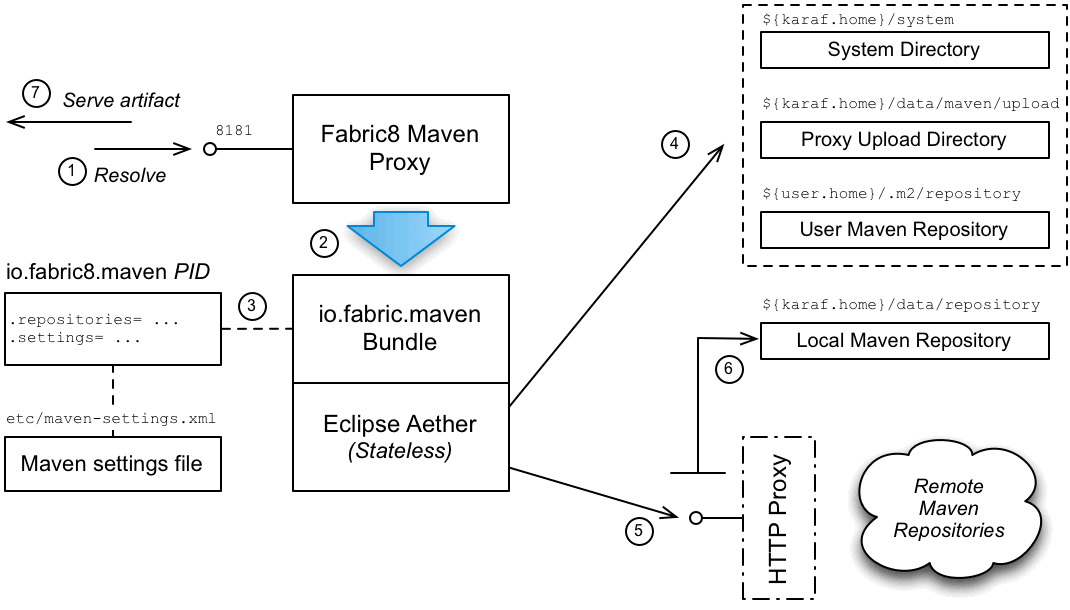14.3. How a Maven Proxy Resolves Artifacts
Overview
Copy linkLink copied to clipboard!
A Maven proxy is essentially a Web server that is configured to behave like a standard Maven repository server. Remember that the purpose of the Maven proxy is to serve artifacts to remote HTTP clients, not to install artifacts locally. So, although Maven proxy configuration properties have similar names to the managed container case, they ultimately serve quite a different purpose.
Fabric8 Maven proxy server
Copy linkLink copied to clipboard!
The Fabric8 Maven proxy server is a HTTP server, implemented as a servlet inside the container's default Jetty container. Hence, the Maven proxy server shares the same port number, 8181, as many of the other Karaf container services. On a given host,
Host, the Maven proxy can be accessed through the following URL:
http://Host:8181/maven/download
http://Host:8181/maven/download
The Fabric8 Maven proxy server is configured by setting properties from the
io.fabric8.maven PID and these properties are normally set in the default profile (recommended).
Note
Some other properties are configurable through the
io.fabric8.maven.proxy PID, but these properties do not play an important role in artifact resolution.
Serving artifacts through the Maven proxy
Copy linkLink copied to clipboard!
Figure 14.2, “Maven Proxy Serving an Artifact” shows how a Maven proxy processes a HTTP download request, by locating the requested Maven artifact and then returning it to the client.
Figure 14.2. Maven Proxy Serving an Artifact
Steps to serve artifacts
Copy linkLink copied to clipboard!
The steps to serve the required Maven artifacts are, as follows:
- Resolution of a Maven artifact is triggered when a managed container sends a request to the Maven proxy server.
- The Maven proxy server parses the incoming HTTP request and then makes a call to the
io.fabric8.mavenlayer, asking it to resolve the requested Maven artifact. - The
io.fabric8.mavenlayer reads its Maven configuration from theio.fabric8.mavenPID in thedefaultprofile (and possibly also from themaven-settings.xmlfile, if so configured). - When the Aether library is invoked, the first step is to look up the Maven default repositories to try and find the Maven artifact. The following default repositories are configured by default:
InstallDir/system- The JBoss A-MQ system directory, which contains all of the Maven artifacts that are bundled with the JBoss A-MQ distribution.
InstallDir/data/maven/upload- The Maven proxy's upload directory, which is used to store artifacts that have been directly uploaded to the Maven proxy—see Section 14.7, “Automated Deployment”.
UserHome/.m2/repository- The user's own local Maven repository in the user's home directory,
UserHome.
If the Maven artifact is found locally, skip straight to step 7. - The Aether library now begins the process of consulting the remote repositories (as specified by the
io.fabric8.maven/io.fabric8.maven.repositoriesPID property which references theio.fabric8.agent/org.ops4j.pax.url.mvn.repositoriesPID property). This process works in tandem with the local Maven repository (as specified by theio.fabric8.maven/io.fabric8.maven.localRepositoryPID property), which acts as a cache for the remote repositories.NoteIf your local network requires you to use a HTTP proxy to access the Internet, it is possible to configure Fabric8 to use a HTTP proxy. For example, see the section called “Configuring an HTTP proxy” for details. - If the Maven artifact is found in a remote repository, Aether automatically installs the artifact into the local Maven repository,
InstallDir/data/repository, so that another remote lookup will not be required. - The Maven proxy server returns the successfully located Maven artifact to the client (or an error message, if the artifact could not be found).
